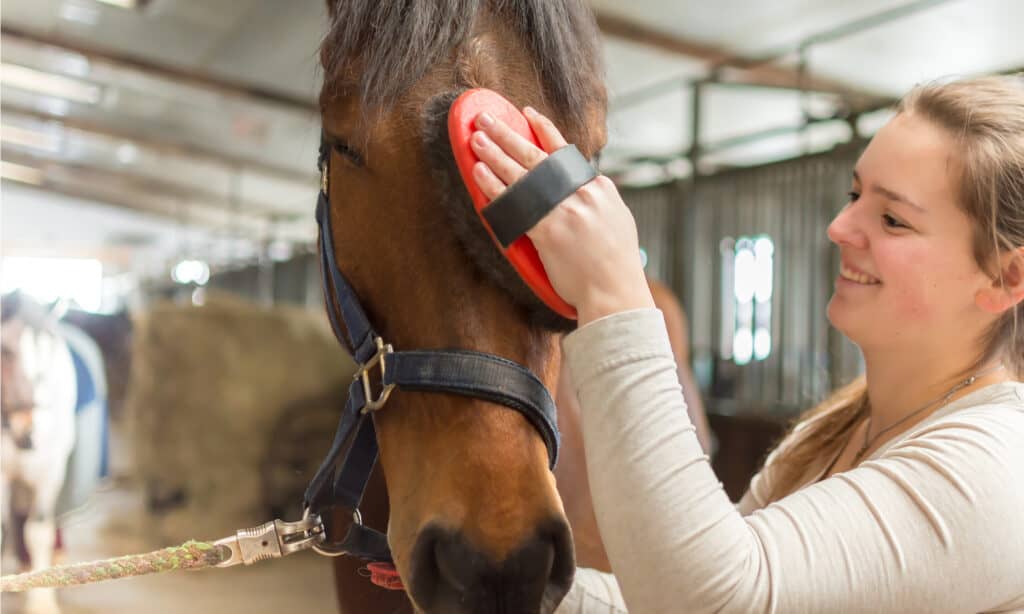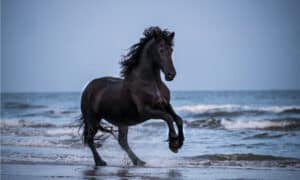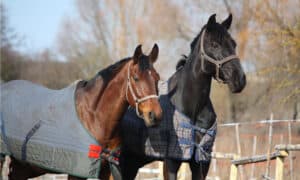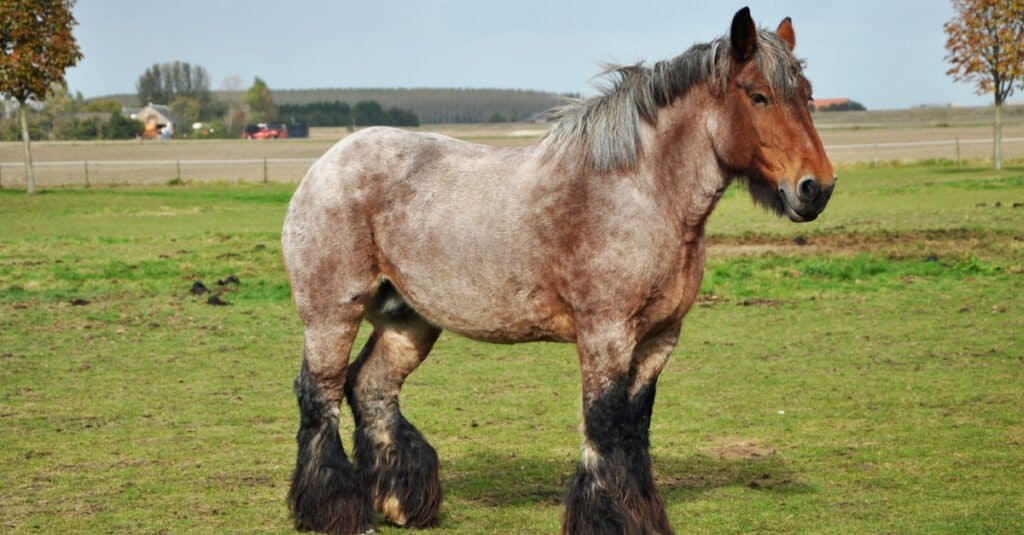People use horses for a variety of purposes, including racing and other economic activities, and as adorable family pets. Regardless of your horse’s exact role, beyond being a live animal, it can be a worthwhile investment. That’s why it’s crucial to have the proper equestrian insurance to protect your horse from injury.
Fortunately, our team of copywriters work hard to help you get everything you need to know about horse insurance, including costs. But before we get too excited, let’s take a closer look at this important report.

©Tanja Esser/Shutterstock.com
5,712 people failed the quiz
do you think you can
Types of Horse Insurance
If you’re eager to get horse insurance, read on to learn what types of coverage are available. We’ll discuss how much they cost, and which one is best for you.
Mortality/Theft
A death/theft policy is the most basic coverage, which is necessary before getting additional coverage. If you are new to owning a horse, it is only covered for the purchase price. When a horse is shown to be more popular in terms of profits, performance history, breeding income and/or training expenditures, the value of the horse’s insurance can be increased.
If your horse dies or is stolen while insured, you will be reimbursed for the horse’s insured value. Death due to willful neglect or abuse is not covered. Depending on your policy, you may be subject to additional exclusions.

Top Horse Repellents

The Best Horse Blankets to Keep Warm in Winter

Top Saddles of 2022
Before purchasing death/theft insurance, you must choose whether you want limited coverage or full coverage. Limited coverage has exclusions, but full coverage is broad and covers not only death from natural causes, but also death from humanitarian and other causes.
The insurance company calculates the annual cost as a percentage of your horse’s estimated value, and the insurance company sets a minimum policy pricing range of $150 to $250.
professional medical
When the cost of veterinary care for lameness, trauma and colic treatments rises, uninsured horse owners can face a big problem, forcing them to opt for euthanasia if they simply cannot afford the health care their horses need.
Large health insurance coverage may help you ease the financial stress that can keep you from making tough decisions. To qualify for major medical insurance, you must first purchase death/theft insurance to protect your horse.
The coverage limit you choose determines your premiums. Primary health insurance with a $5,000 cap costs an average of about $200 a year. A $7,500 limit costs about $340 a year, a $10,000 limit costs about $450, and a $15,000 limit costs about $675. According to Colorado State University, most colic sufferers walk away with bills ranging from $3,500 to $5,500; in more difficult cases, costs can rise to tens of thousands of dollars.
Once you have insured your horse, you must give all necessary treatment to save your horse. If your horse requires surgery for colic and you choose to euthanize rather than subject the horse to the trauma of the surgery, the insurance company is not obligated to pay the insurance. If all efforts are made to save the horse and it does not survive, you will be reimbursed under your insurance.
Deductibles are part of all major medical insurance plans. The deductible is usually $300, but may vary by carrier. Most pet insurance companies do not cover routine veterinary services such as pre-existing conditions, elective surgeries, and vaccinations.

© defotoberg/Shutterstock.com
Accidental Sickness (ASD)
ASD insurance covers investment stallions. This policy will reimburse your stallion for the insured value if your stallion is rendered incapable of reproduction due to accident, disease or infection.
You need to demonstrate the horse’s potential as a stallion, especially since he bedded mares for at least one mating season before coverage began. Your veterinarian will also want to examine your sperm. If your stallion is no longer capable of breeding and you want reimbursement for its insured value, the insurance company will need to castrate the stallion.
loss of use
Depending on your horse’s performance level, losing use may make sense to you. Show horses competing at the highest level, including reining, western pleasure or cutting, are more likely to be subject to loss of use restrictions.
Loss of use coverage for recreational horseback riding is unlikely to be available.
There are two types of loss coverage: accidental (limited loss) and total loss. Accidental or limited loss insurance will cover a portion of the horse’s full value if the horse becomes unable to perform its original purpose due to an accident.
Total loss coverage will pay a portion of your horse’s value if an accident or medical illness such as equine encephalomyelitis prevents the horse from performing its assigned function.
Horse Insurance Costs
Like any other insurance, cheap horse insurance isn’t always the best option. Researching horse insurance rates is important, but carefully consider your deductibles, underwriting procedures, and any additional out-of-pocket costs.
On average, you should expect to spend $150 to $200 a year on $5,000 of primary health insurance. The percentage of people receiving coverage for surgery varies widely. Mortality insurance premiums for your horse depend on its age, use and value. Depending on the insured value of your horse, the annual premium can be as high as 3%.
things to consider
When comparing horse insurance providers and plans, there are several aspects to consider.
pre-existing conditions
Each year, equine insurance plans revise their limits and what constitutes a pre-existing condition. Even if you renew your policy, it’s still considered a new policy term. So if something happens to your horse while it’s insured, the insurance company may treat it as a pre-existing condition next year.
limit
The exclusions in the policy are subject to change, so please be aware and read the details carefully. Many horse insurance plans do not cover horses over the age of 15, and horses with pre-existing or degenerative diseases.
Company reputation
Because horse health insurance requires expertise, it’s best to work with a livestock medical and death insurance specialist. You should also verify that the company’s underwriters are livestock specialists. How long has the company been in operation? What is their track record? Do your research to get insurance with a reputable and trustworthy reputation.
the bottom line
Owning a horse for recreation or competition is a wonderful thing. Paying ridiculously high veterinary bills is not. Considering horse insurance can save you a lot of money, and fast. Ask yourself if it’s worth it, and be sure to do plenty of research to find the best insurance for your horse and your wallet.
next
- 13 Largest Horses In The World
- The Top Horse Insect Repellents of 2022
- 10 most beautiful horses in the world
- Top Saddles of 2022

I am broadly interested in how human activities influence the ability of wildlife to persist in the modified environments that we create.
Specifically, my research investigates how the configuration and composition of landscapes influence the movement and population dynamics of forest birds. Both natural and human-derived fragmenting of habitat can influence where birds settle, how they access the resources they need to survive and reproduce, and these factors in turn affect population demographics. Most recently, I have been studying the ability of individuals to move through and utilize forested areas which have been modified through timber harvest as they seek out resources for the breeding and postfledging phases. As well I am working in collaboration with Parks Canada scientists to examine in the influence of high density moose populations on forest bird communities in Gros Morne National Park. Many of my projects are conducted in collaboration or consultation with representatives of industry and government agencies, seeking to improve the management and sustainability of natural resource extraction.











